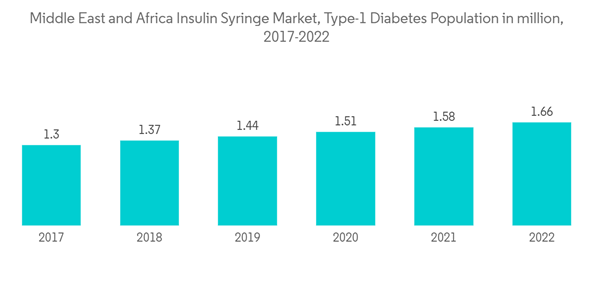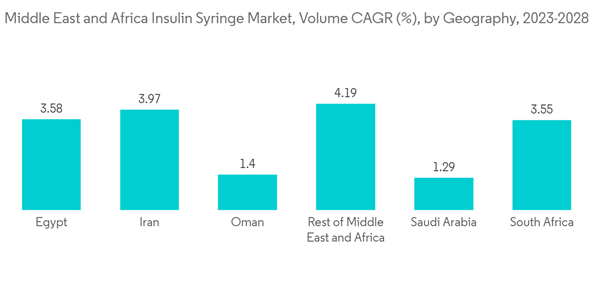The market is estimated to reach a value of more than USD 1 billion by 2027.
The COVID-19 pandemic positively impacted the Insulin Syringe market growth in the Middle East and African region. Patients with diabetes, infected with SARS-CoV-2 experience additional stress and increased secretion of hyperglycemic hormones, which results in elevated blood glucose, abnormal glucose variability, and diabetic complications. Diabetes and uncontrolled hyperglycemia are risk factors for poor outcomes in patients with COVID-19 including an increased risk of severe illness or death. Diabetes is associated with many health complications. To avoid complications, a patient's blood glucose level should be maintained at a normal level.
Patients with diabetes require many corrections throughout the day to maintain nominal blood glucose levels, such as administering additional insulin or ingesting additional carbohydrates by monitoring their blood glucose levels. The manufacturers of Insulin Syringes have taken care during COVID-19 to deliver insulin delivery devices to diabetes patients with the help of local governments.
Diabetes poses an emerging healthcare burden across the region. Comparing the population with and without diabetes, those with diabetes have a 300% increased risk of being hospitalized and thus incur more healthcare expenses compared to non-diabetic people. Furthermore, patients attempting to control their blood glucose levels tightly to prevent the long-term complications associated with fluctuations in blood glucose levels are at greater risk for overcorrection and the resultant hypoglycemia. Achieving nominal results can be very difficult without multiple daily injections of insulin or insulin pump therapy.
Owing to the aforementioned factors the studied market is anticipated to witness growth over the analysis period.
MEA Insulin Syringe Market Trends
Rising diabetes prevalence
Owing to the aforementioned factors, the studied market is anticipated to witness growth over the analysis period.The diabetes population in the Middle East and Africa region is expected to rise by more than 3.5% over the forecast period.
73 million adults lived with diabetes in the IDF MENA region in 2021. This figure is estimated to increase to 95 million by 2030. 48 million adults in the IDF MENA region are living with impaired glucose tolerance, which places them at increased risk of developing type-2 diabetes. Technological advancements have increased over the years in insulin delivery devices for safer and more accurate administration of insulin.
Governments in the ME have identified the threat of diabetes and started to respond with various policies, initiatives, and programs. Six out of 15 countries in this region still do not have a national operational action policy for diabetes. Many countries still do not have a national strategy to reduce overweight, obesity, and physical inactivity, which are important risk factors for diabetes. Most counties have fully implemented national diabetes treatment guidelines. However, constant measures are being taken to minimize diabetic complications; therefore, owing to the aforesaid factors, the growth of the studied market is anticipated in the Middle East and Africa region.
Iran is expected to dominate the Middle East and Africa Insulin Syringe Market over the forecast period
Iran holds the largest share in the insulin syringe market in the Middle East and Africa region in the current year and is expected to register a CAGR of 3.9% over the forecast period.Diabetes is a serious public health concern in Iran, the Middle East's second-largest country, due to its high prevalence rate, growing occurrence rate, and economic impact. According to IDF 2021, it is estimated that by the year 2030, 9.2 million Iranian individuals are expected to have diabetes. Diabetes has significant economic consequences for the country. Diabetes, in addition to its high direct health care costs, is a significant risk factor for other chronic illnesses such as cardiovascular disease.
The prevalence of diabetes is related to socio-demographic factors, which require attention to the role of these factors in controlling the disease. Diabetes is more common in women, the insured, the low-educated, housewives, and people with a positive family history of the disease, and it increases with age. Although most of the patients are aware of their disease, their blood glucose is not adequately controlled in half of them. Despite the widespread availability of drugs and insulin coverage in Iran, the estimated national control of hyperglycemia, hyperlipidemia, and hypertension remains inadequate.
Pre-diabetes and undiagnosed diabetes are more common among the less educated, older, unemployed, and housewives. Effective strategies are needed for diabetes prevention and control in this population. Design and implementation of patients' registries, international research collaborations in technological advancement, and active follow-up programs can prove helpful in the adoption of diabetes care.
However, the roll-out of new products and increasing awareness about diabetes among people are some of the market opportunities for the players in the market.
MEA Insulin Syringe Industry Overview
The Middle East and Africa insulin syringe market is moderately fragmented and has been driven by constant innovations by manufacturers to compete in the market. The major players, such as Becton Dickinson and Terumo, resort to inorganic market strategies, such as mergers and acquisitions, to establish market dominance while also adhering to organic growth strategies, which is evident from the R&D spending of these companies.Additional Benefits:
- The market estimate (ME) sheet in Excel format
- 3 months of analyst support
This product will be delivered within 2 business days.
Table of Contents
Companies Mentioned (Partial List)
A selection of companies mentioned in this report includes, but is not limited to:
- Becton Dickinson
- Terumo Corporation
- HMD Healthcare Ltd.
- Retractable Technologies, Inc.
- Ultimed Inc.
Methodology

LOADING...










